Below are the three solutions:
Fastest is using a for loop and storing it in a Dict.
import time
from collections import Counter
def countElement(a):
g = {}
for i in a:
if i in g:
g[i] +=1
else:
g[i] =1
return g
z = [1,1,1,1,2,2,2,2,3,3,4,5,5,234,23,3,12,3,123,12,31,23,13,2,4,23,42,42,34,234,23,42,34,23,423,42,34,23,423,4,234,23,42,34,23,4,23,423,4,23,4]
#Solution 1 - Faster
st = time.monotonic()
for i in range(1000000):
b = countElement(z)
et = time.monotonic()
print(b)
print('Simple for loop and storing it in dict - Duration: {}'.format(et - st))
#Solution 2 - Fast
st = time.monotonic()
for i in range(1000000):
a = Counter(z)
et = time.monotonic()
print (a)
print('Using collections.Counter - Duration: {}'.format(et - st))
#Solution 3 - Slow
st = time.monotonic()
for i in range(1000000):
g = dict([(i, z.count(i)) for i in set(z)])
et = time.monotonic()
print(g)
print('Using list comprehension - Duration: {}'.format(et - st))
Result
#Solution 1 - Faster
{1: 4, 2: 5, 3: 4, 4: 6, 5: 2, 234: 3, 23: 10, 12: 2, 123: 1, 31: 1, 13: 1, 42: 5, 34: 4, 423: 3}
Simple for loop and storing it in dict - Duration: 12.032000000000153
#Solution 2 - Fast
Counter({23: 10, 4: 6, 2: 5, 42: 5, 1: 4, 3: 4, 34: 4, 234: 3, 423: 3, 5: 2, 12: 2, 123: 1, 31: 1, 13: 1})
Using collections.Counter - Duration: 15.889999999999418
#Solution 3 - Slow
{1: 4, 2: 5, 3: 4, 4: 6, 5: 2, 34: 4, 423: 3, 234: 3, 42: 5, 12: 2, 13: 1, 23: 10, 123: 1, 31: 1}
Using list comprehension - Duration: 33.0

